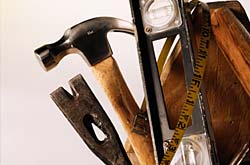Home Improvements in the Big City
See if We Have Top-Rated
Home Improvement Pros in Your Area

At times, the home improvement industry gets tunnel-vision toward its suburban market with bigger homes, more bathrooms, and wealthier residents, but in big cities, a very different home improvement culture exists. This culture still wants the best home environment possible, but may find fewer sources that speak to their circumstances. Here's an overview, a few tips, and cost estimates for home improvements common to big-city areas.
Dealing with Loud Noises and Bright Lights in the Big City
The sights and sounds is part of the charm of any thriving metropolis, but this charm can wear off, once it infiltrates bedrooms and other cozy living spaces. Some city-dwellers develop a Zen-like habituation, but some noises can just be too much for many residents. The direst circumstances require the most dramatic solutions: The average cost of soundproof insulation is $2,036, according to HomeAdvisor, leading online resource connecting homeowners and home improvement contractors. The best solution, like it is with energy-efficiency, may be to focus on reducing the noise that comes through your windows. New soundproof glass might cost around $500-$750 per window.
When it comes to lighting, the problem can quickly become two-pronged. First, you may need black-out curtains to shield your residence from epilepsy-causing neon signs or the leering eyes of cross-alley neighbors. For help with specific issues concerning window coverings, you might solicit the help of a professional. The average cost of professional window covering installation is $644, although projects can easily range from as little as $100 to $2,000 or more, according to HomeAdvisor. On the other side of the coin, adjacent buildings may be keeping natural sunlight from entering your windows. Contemporary lighting design is huge in urban areas for just this reason. The average cost of professional lighting design and installation is $2,490.
Interior Design for Small Spaces: Avoid Crime and Punishment
Let's hope you don't commit murder like the protagonist of the Russian novel, but city living can cause many people to become more than a little stir-crazy in miniscule apartment spaces. Often, this cramped reality puts residents and tenants in a difficult position. Unable to knock down a wall or install significant built-in cabinets and nooks without approval from the landlord, tenants must look for subtler alternatives. Here are some of the more common problems and possible solutions for urban residents:
Limited Storage/Living Space: When this happens, think high and keep things moving: Look for places where you can install cabinets or shelves near the ceiling, keeping things off the floor to create additional living space. Also, moving parts such as platform storage beds and roll-out cabinets in the kitchen and throughout the house can multiply the nooks and crannies available for storage.
Limited Number of Rooms: Often, there's only so much that can be done about this problem in a cost-effective way. Yet, many residents underestimate the ability of smart interior design and a few additions to combine rooms. A breakfast nook or alcove can streamline the function of the interior triangle—kitchen, dining room, living room. Wall partitions may be one solution, but in many urban areas the space is already so small that you run the risk of turning rooms into cubicles.
Limited Space is Cramped Space: You may have a place for everything, but your home still doesn't feel right. Small living spaces still require a good portion of empty space to make rooms feel comfortable. Effective lighting design will help, but you may need to look for solutions, like the ones above, just to make your space feel less cramped.
The Urban Budget: A Tale of Two Cities
Hire a Professional
The urban home improvement scene is a tale of two cities—not Paris and London but, as Dickens was writing about, one of affluence and poverty. While the discrepancy in other cities may not be quite as dramatic, the underlying reality of haves and have-nots is at play in every major U.S. city. Likewise, two types of home improvement industries are at play in these cities. The influx of affluent urbanites tends to result in major renovation projects, especially kitchen and bathroom remodeling. Long-term residents with lower socio-economic status, on the other hand, are more likely to be holding their residence together from paycheck-to-paycheck, constantly needing repairs to furnaces and air conditioners, appliances and plumbing.
With any of these issues, an interior designer/decorator can be worth every penny of his or her fee. Helping choose furniture and furnishings with reflective surfaces that don't clash, finding the right spacious effects with your interior paint, pointing out the optimal place and size for storage shelving, cabinets, and closets, and, in the end, simply brainstorming various design concepts, while identifying ideas that simply won't work logistically, can be an enormous asset.
More Tips & Advice For Your Home
- Related Articles
- Recent Articles

